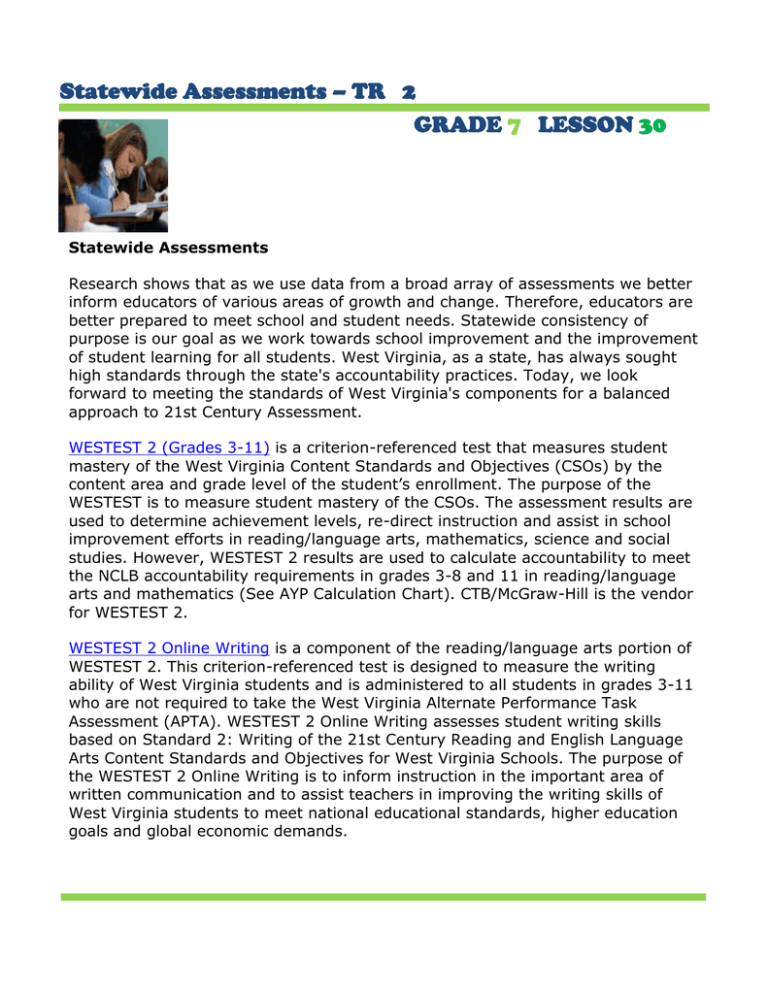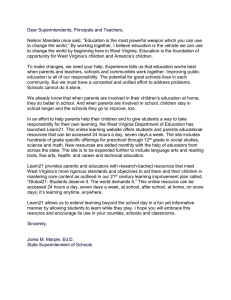Statewide Assessments – TR 2 GRADE LESSON
advertisement

Statewide Assessments – TR 2 GRADE 7 LESSON 30 Statewide Assessments Research shows that as we use data from a broad array of assessments we better inform educators of various areas of growth and change. Therefore, educators are better prepared to meet school and student needs. Statewide consistency of purpose is our goal as we work towards school improvement and the improvement of student learning for all students. West Virginia, as a state, has always sought high standards through the state's accountability practices. Today, we look forward to meeting the standards of West Virginia's components for a balanced approach to 21st Century Assessment. WESTEST 2 (Grades 3-11) is a criterion-referenced test that measures student mastery of the West Virginia Content Standards and Objectives (CSOs) by the content area and grade level of the student’s enrollment. The purpose of the WESTEST is to measure student mastery of the CSOs. The assessment results are used to determine achievement levels, re-direct instruction and assist in school improvement efforts in reading/language arts, mathematics, science and social studies. However, WESTEST 2 results are used to calculate accountability to meet the NCLB accountability requirements in grades 3-8 and 11 in reading/language arts and mathematics (See AYP Calculation Chart). CTB/McGraw-Hill is the vendor for WESTEST 2. WESTEST 2 Online Writing is a component of the reading/language arts portion of WESTEST 2. This criterion-referenced test is designed to measure the writing ability of West Virginia students and is administered to all students in grades 3-11 who are not required to take the West Virginia Alternate Performance Task Assessment (APTA). WESTEST 2 Online Writing assesses student writing skills based on Standard 2: Writing of the 21st Century Reading and English Language Arts Content Standards and Objectives for West Virginia Schools. The purpose of the WESTEST 2 Online Writing is to inform instruction in the important area of written communication and to assist teachers in improving the writing skills of West Virginia students to meet national educational standards, higher education goals and global economic demands. WESTEST 2 is a custom-designed assessment for West Virginia students. The individual content assessments measure a student’s levels of performance on clearly defined standards and objectives and skills. Student scores are based on test questions that have been developed and aligned to the West Virginia 21st Century CSOs. WESTEST 2 Online Writing is a part of the reading/language arts portion of WESTEST 2. Sample test questions may be found on the Teach 21 website. The assessment results provide information about a student’s academic strengths, as well as areas that need improvement. The parent/guardian will receive a student report that indicates levels of performance in each of the content areas. Student performance is measured by West Virginia academic standards rather than a comparison to the performance of a national sample population of students. Results of the tests will be used by educators to improve student learning and performance. The West Virginia Department of Education recently initiated a media campaign to inform the public how education in West Virginia is changing as schools move towards Global 21 education. The Test Your Knowledge newspaper ads along with other media are posted on our website. Also, as a support to educators in charting student performance in meeting global challenges, the West Virginia Department of Education has provided instructional benchmarks designed to assess student progress over the course of the school year. These instructional benchmarks are available on the Acuity Platform and the Writing RoadMap 2 Websites. ACT EXPLORE (Grade 8) is a norm-referenced assessment that generates measures of English, mathematics, reading, and science skills for 8th grade students. In addition, information about students' educational career plans, interest, high school course work plans and self-identified needs for assistance is gathered and reported. West Virginia State Board of Education Policy 2510: Assuring the Quality of Education Regulations for Education Programs requires that career awareness, exploration activities and ACT EXPLORE results be used by 8th graders to develop their individualized plans for the 9th and 10th grades. The purpose of this assessment is to provide career awareness, exploration activities; additionally, it is used by 8th graders to develop their individualized plans for the 9th and 10th grades. Assessment results assist students/parents/educators in decision-making about educational career plans, interest and high school course work plans. ACT is the vendor for ACT EXPLORE. ACT Plan (Grade 10) is a norm-referenced assessment that generates measures of English, mathematics, reading and science skills for 10th grade students. Information about students' educational career plans, interest, high school course work plans and self-identified needs for assistance are also gathered and reported. The purpose of this assessment is to provide career awareness, exploration activities; additionally, it is used by 10th graders to revise their individualized plans for the 11th and 12th grades. These assessment results assist students/parents/educators in decision-making about educational career plans, interest, and high school course work plans. ACT is the vendor for ACT Plan. Online Technology Assessment (OTA) has been built on the National Education Technology Standards for Students and the work of the Partnership for 21st Century Skills, the techSteps framework provides a robust set of K-8 technology literacy standards. The techSteps curriculum includes a set of electronic activity books for each grade level. Using these guides, students are launched into real-world applications such as Microsoft Word, Excel, PowerPoint, and Internet Explorer. Here they learn new technology skills as they work through meaningful Math, Science, Language Arts, and Social Studies activities. Authentic assessment is possible because students are building their own information products using real-world software applications. Assessment and reporting options are available to meet teacher and district needs. For example, each learning activity includes an assessment rubric tied to the technology literacy standards. From: http://wvde.state.wv.us/oaa/

